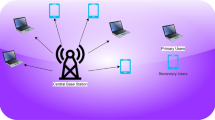Abstract
Based on the IEEE 802.16e standard, WiMAX has proposed a relay-based mechanism, namely IEEE 802.16j, to extend the service area of the Multihop Relay Base Stations (MR-BSs) and to improve the Received Signal Strength quality. IEEE 802.16j thus can achieve two significant advantages: extending the WiMAX service area with a low-cost solution and compatible with the existing WiMAX specifications. The Relay Station (RS) can be classified into three types: Fixed RS, Nomadic RS and Mobile RS according to diverse features of mobility and relaying range. A multihop-relay WiMAX network including various types of RSs exhibits a critical routing issue, i.e., how to determine an efficient relay-based routing path between a Mobile Station (MS) and a MR-BS. This paper thus proposes an IEEE 802.16j-conformed relay-based adaptive competitive on-line routing approach that focuses on the Non-Transparent Relay-Station (NT-RS) mode, where the path with the least cost and the highest AMC coding rate will be selected in terms of the link bandwidth, path length and channel conditions. Numerical results indicate that the proposed routing approach significantly outperforms other approaches in Fractional Reward Loss, network utilization and average end-to-end path delay.
Similar content being viewed by others
References
IEEE 802.16j. (2008). Baseline document for draft standard for local and metropolitan area networks Part 16: Air Interface for Fixed and Mobile Broadband Wireless Access Systems, July, 2008.
IEEE Standard for Local and metropolitan area networks Part 16: Air Interface for Fixed and Mobile Broadband Wireless Access Systems Amendment 2: Physical and Medium Access Control Layers for Combined Fixed and Mobile Operation in Licensed Bands and Corrigendum 1, IEEE Std 802.16e-2005 and IEEE Std 802.16-2004/Cor 1-2005 (pp. 0_1–822), February, 2006.
Cao, L., & Dahlberg, T. (2006, April). Path cost metrics for multi-hop network routing. In 25th IEEE international performance computing and communications conference (pp. 15–21).
Malakooti, B., & Thomas, I. (2006, April). A distributed composite multiple criteria routing using distance vector. In IEEE international conference on networking, sensing and control (pp. 42–47).
Wang N.-C., Huang Y.-F., Chen J.-C. (2007) A stable weight-based on-demand routing protocol for mobile ad hoc networks. Information Sciences 177(24): 5522–5537
Cao, L., Sharif, K., Wang, Y., & Dahlberg, T. (2008, January). Adaptive multiple metrics routing protocols for heterogeneous multi-hop wireless networks. In IEEE Consumer Communications and Networking Conference (pp. 13–17).
So J., Vaidya N. H. (2007) Routing in multi-channel hybrid wireless networks With single network interface. IEEE Transactions on Vehicular Technology 56(1): 342–348
Tsai, T.-C., & Wang, C.-Y. (2007, July). Routing and eAdmission control in IEEE 802.16 distributed mesh networks. In International conference on wireless and optical communications networks (pp. 1–5).
Wang, S.-S., Yin, H.-C., Tsai, Y.-H., & Sheu, S.-T. (2007, July). An effective path selection metric for IEEE 802.16-based Multi-hop relay networks. In IEEE symposium on computers and communications (pp. 1051–1056).
Wang, B., & Mutka, M. (2008, June). Path selection for mobile stations in IEEE 802.16 multihop relay networks. In International symposium on a world of wireless mobile and multimedia networks (pp. 1–8).
Ann, S., Lee, K. G., & Kim, H. S. (2008, August). A path selection method in IEEE 802.16j mobile multi-hop relay networks. In International conference on sensor technologies and applications (pp. 808–812).
Okuda M., Zhu C., Viorel D. (2008) Multihop relay extension for WiMAX networks—overview and benefits of IEEE 802.16j standard. Fujitsu Science and Technology Journal 44(3): 292–302
Fu, I.-K., Sheen, W.-H., & Ren, F.-C. (2007, December). Deployment and radio resource reuse in IEEE 802.16j multi-hop relay network in manhattan-like environment. In International conference on information, communications & signal processing (pp. 1–5).
Hwang, R.-H., Hsiao, W.-C., & Chang, B.-J. (2004, February). Multiple classes of QoS guarantee in distributed multicast routing. In The 6th international conference on advanced communication technology (Vol. 2, pp. 949–954).
Chang B.-J., Chen Y.-L. (2008) Adaptive hierarchical polling and Markov decision process based call admission control for minimizing polling delay and increasing network reward in IEEE 802.16 WiMAX networks. Computer Communications 31(10): 2280–2292
Gawlick, R., Kamath, A., Plotkin, S., & Ramarkrishnan, K. (1995). Routing and admission control in general topology networks. Technical report STAN-CS-TR-95-1548, Stanford University.
Allan B., El-Yaniv R. (1998) Online computation and competitive analysis. Cambridge University Press, Cambridge
Zhang, L., Andrews, M., Aielo, W., Bhatt, S., & Krishnan, K. R. (1997, November). A performance comparison of competitive on-line routing and state-dependent routing. In GLOBECOM’97 (pp. 1813–1819).
Shin, J. S., Kumar, R., Shin, Y. S., & La Porta, T. F. (2008, March). Multi-hop wireless relay networks of mesh clients. In IEEE wireless communications and networking conference (pp. 2717–2722).
Mogre, P. S., Hollick, M., Dimitrov, S., & Steinmetz, R. (2009, October). Incorporating spatial reuse into algorithms for bandwidth management and scheduling in IEEE 802.16j relay networks. In IEEE local computer networks 2009 (pp. 384–391).
Yao, Y., & Sun, J. (2005, June). Study of UGS grant synchronization for 802.16. In ISCE 2005 (pp. 105–110).
Wang, H., Li, W., & Agrawal, D. P. (2005, April). Dynamic admission control and QoS for 802.16 wireless MAN. In Wireless telecommunications symposium 2005 (pp. 60–66).
Cicconetti C., Lenzini L., Mingozzi E., Eklund C. (2006) Quality of service support in IEEE 802.16 networks. IEEE Network 20(2): 50–55
Lin, C.-W., Chen, Y.-C., & Pang, A.-C. (2006, August). A new resource allocation scheme for IEEE 802.16-based networks. In IEEE VTS Asia Pacific wireless communications symposium (pp. 1–5).
Author information
Authors and Affiliations
Corresponding author
Additional information
This research was supported in part by the National Science Council of Taiwan, ROC, under Grants NSC-96-2221-E-324-019 and NSC-97-2221-E-224-072-MY3.
Rights and permissions
About this article
Cite this article
Liang, YH., Chang, BJ., Su, SS. et al. Adaptive Cost-Based with Max–Min AMC Routing Algorithm for Increasing Utilization and Reducing Blocking in IEEE 802.16j WiMAX Networks. Wireless Pers Commun 62, 577–597 (2012). https://doi.org/10.1007/s11277-010-0081-x
Published:
Issue Date:
DOI: https://doi.org/10.1007/s11277-010-0081-x




